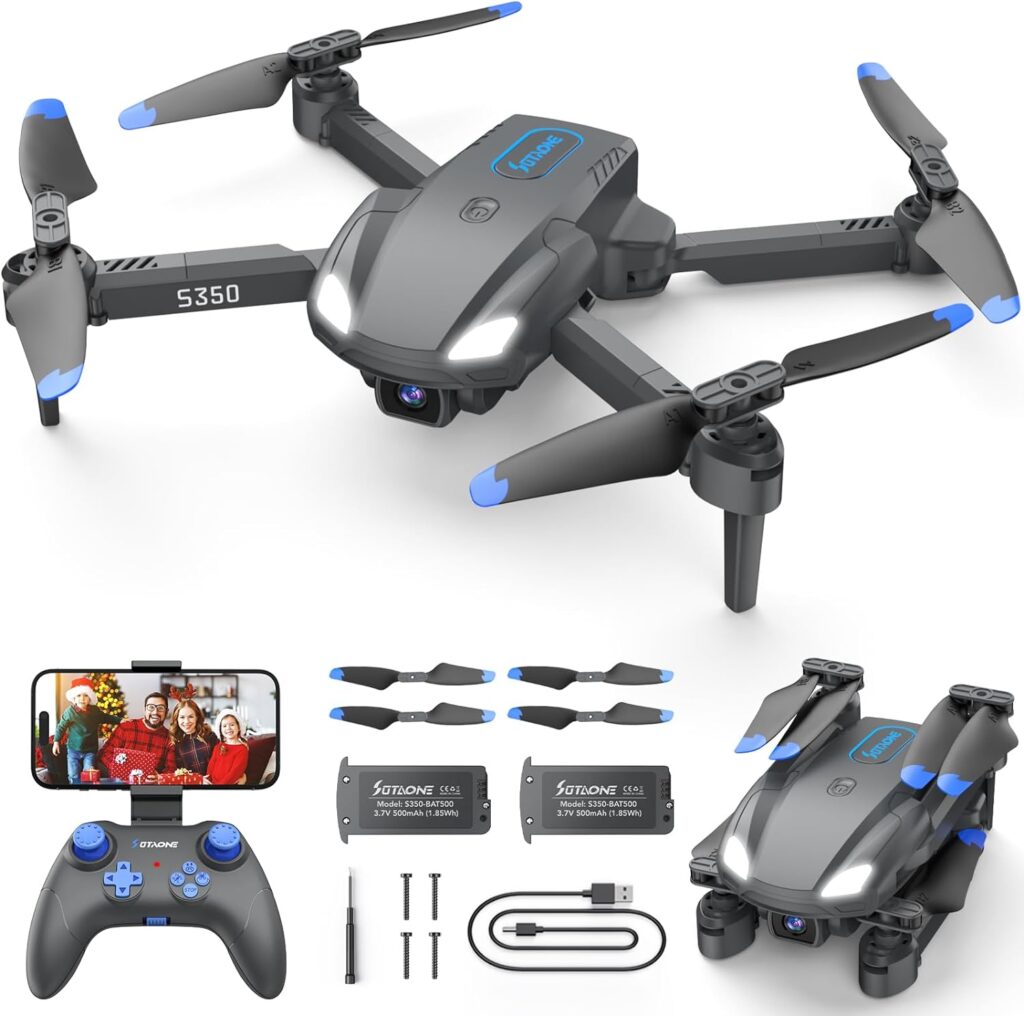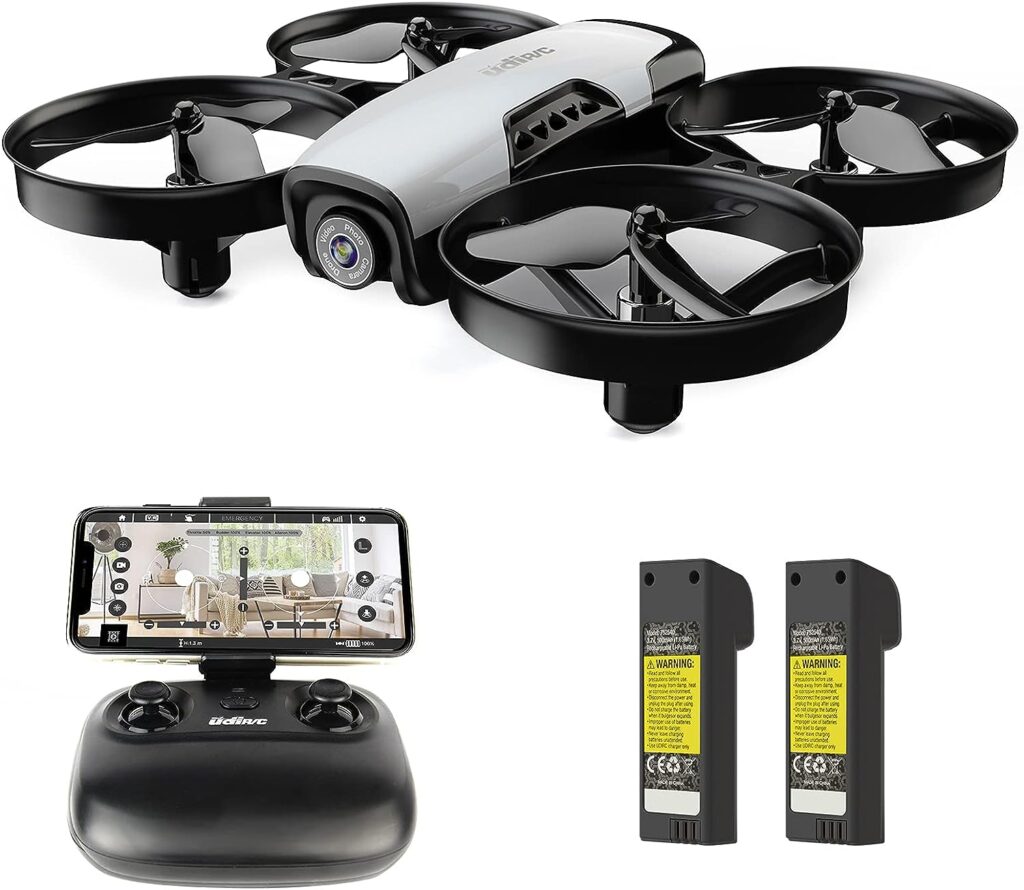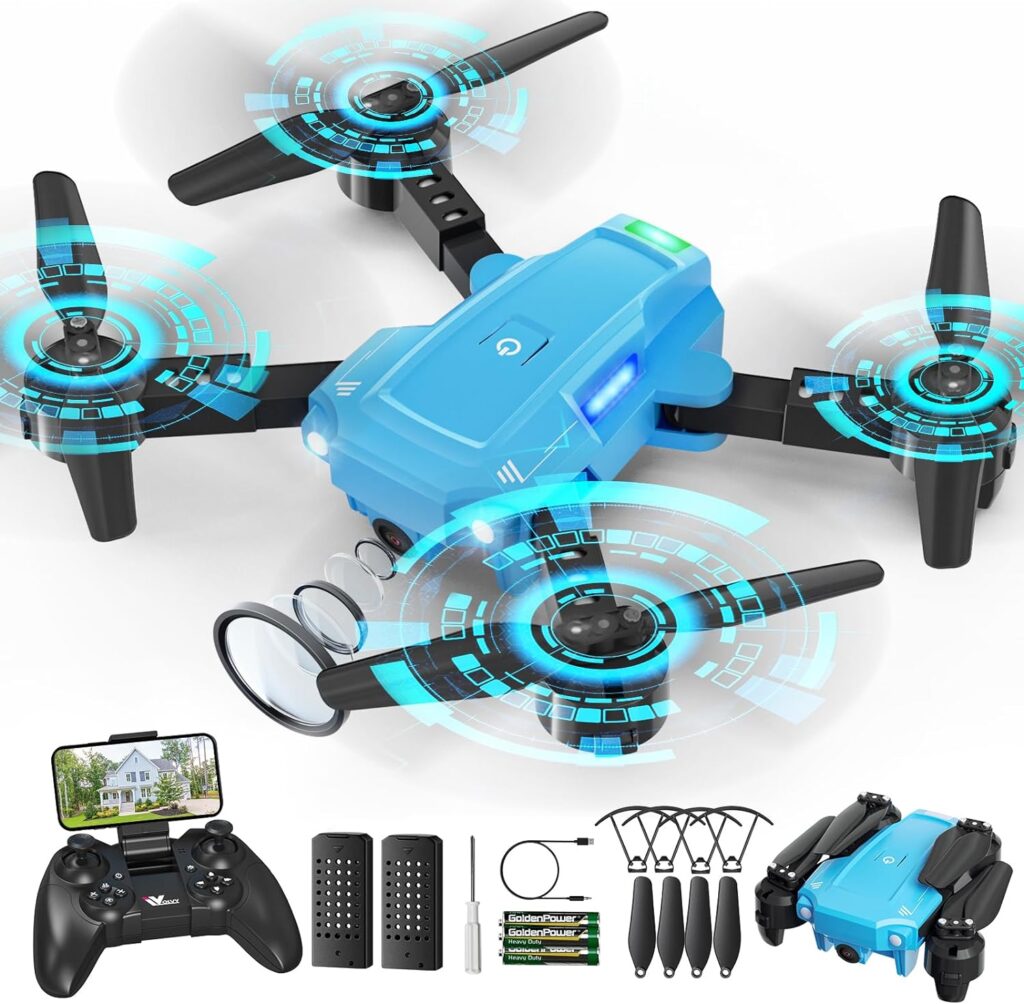Drone for Kids: A Comprehensive Guide to Safe and Fun Flying
Introduction to Drones for the Youngsters
Remember when kites were the most exciting thing to send skyward? Enter the age of drones! With technology advancing, even our youngest can now pilot their very own remote control drone for kids. Understanding different drone parts and how they operate can also provide an educational insight. Let’s navigate this buzzing world together!
Why Kids Love Drones
Drones, with their high-flying capabilities and cutting-edge technology, have become a fascinating attraction for kids worldwide. But what exactly about these drones captivates young minds? Below, we explore several reasons why drones are not just toys but tools for education, creativity, and personal development for children.
Embracing Technology
- Digital Natives: In an era where technology is omnipresent, children are growing up as digital natives. Their world is surrounded by advanced gadgets like tablets, smartphones, and now, drone for kids. These devices are more than just playthings; they represent a comfortable and intuitive interface for children to interact with the world.
- Hands-on Experience: Drones provide a hands-on experience that is both educational and entertaining. They serve as a practical introduction to the basics of technology and engineering, making learning both interactive and fun.
Fun and Learning Combined
- Real-life Video Games: Operating a drone for kids are akin to bringing a video game into the real world. It offers an exciting mix of entertainment and skill development. Children learn to navigate and control the drone, turning every flight into a lively and engaging game.
- Skill Development: Mastering drone flight involves learning various maneuvers and techniques, from simple navigation to performing complex aerial tricks. This process is not just entertaining but also educational, fostering a sense of achievement and skill enhancement.
A New Perspective
- Unique Vantage Point: Drones offer a bird’s-eye view of the world, which can be a thrilling experience for children. This unique perspective can ignite curiosity and creativity, encouraging kids to explore and imagine new possibilities.
- Exploring the World: Viewing their surroundings from above opens up new ways for children to connect with their environment. Whether it’s a local park, their backyard, or the neighborhood, drones offer a fresh and exciting way to explore familiar places.
Natural Curiosity
- Exploration and Discovery: Children have an innate desire to explore and understand their world. Drones cater to this curiosity by providing a tangible yet sophisticated tool that goes beyond traditional play. They offer an immersive experience that blends play with discovery.
Mastery and Achievement
- Building Confidence: Learning to control a drone is not always easy. As children overcome challenges and improve their piloting skills, they develop a sense of mastery and achievement. This accomplishment boosts their self-confidence and encourages them to take on new challenges.
Spatial Intelligence
- Cognitive Development: Maneuvering a drone requires a good understanding of spatial relationships. This activity helps in developing spatial intelligence in children, which is crucial for tasks involving distance estimation, understanding of spatial relationships, and navigating through different spaces.
- Enhanced Perception: As children learn to pilot drones, they become more aware of their surroundings. They start to understand how objects relate to each other in space, which is a critical skill not just for drone flying but for everyday life.
Top Drones Suited for Kids

While there are numerous types of drones designed for kids, some truly stand out:
SOTAONE S350 Drone
Pros:
- 1080P HD Camera: Capture stunning aerial scenery with real-time live video.
- Stable Flight: Altitude hold and one-key takeoff/landing make it easy for beginners.
- Aerial Stunts: Perform impressive stunts with 3D flips and high-speed rotation.
- Safety Design: Low power alarm, emergency stop, and propeller guards for added safety.
- Two Batteries: Enjoy up to 20 minutes of flight with two rechargeable batteries.
Cons:
- No Voice/Gesture Control: Lacks advanced control options like voice and gesture commands.
- Limited Range: The maximum control range may be shorter than some other drones.

DROCON Drone with Camera

Pros:
- 1080P Camera: Provides a wider field of view for capturing stunning photos and videos.
- Stable Flight: Altitude hold, headless mode, and emergency stop for easy and safe flying.
- Multi-function Control: Control the drone through your smartphone with various features like gesture recognition and custom path flight.
- Two Batteries: Enjoy up to 24 minutes of flight time with two included batteries.
- Foldable Design: Easy to carry and store with a compact, foldable design.
Cons:
- Higher Price: Priced higher compared to some other beginner drones.
- Complex Features: Advanced features may be overwhelming for absolute beginners.
ACIXX RC Mini Drone
Pros:
- Easy to Use: Toss to launch, auto-hovering, and one-key takeoff/landing make it extremely user-friendly.
- Long Flight Time: Two batteries provide up to 16 minutes of flight time.
- Durable Design: Structured style and propeller guards ensure safe and durable flights.
- Fun Functions: Perform 3D flips and other fun actions with ease.
Cons:
- Lower Camera Quality: The camera quality is lower at 720p compared to some other drones.
- Limited Control Range: The maximum control range may be limited.

Cheerwing U61S Mini Drone

Pros:
- HD 720P FPV Camera: Capture wider landscape photos and videos with real-time viewing on your smartphone.
- Voice and Gesture Control: Use voice commands and gestures for added control and fun.
- User-Friendly: Altitude hold, headless mode, and one-button functions make it easy for beginners.
- Extended Flight: Enjoy up to 24 minutes of flight time with two included batteries.
- Foldable Design: Compact and portable for outdoor travel.
Cons:
- Limited Range: The maximum range may be shorter compared to some other drones.
- Slightly Heavier: Weighs more than some other mini drones.
ORVINA OV-18 Mini Drone
Pros:
- Super Stable Flight: Upgraded gyroscopic stabilization for easy flying, even for kids.
- Safety Cover: Resilient protection cover to prevent accidents.
- Multi-Kid Flying: Multiple kids can fly together for added fun.
- Multiple Batteries: Comes with three batteries for extended flight experiences.
- Beginner-Friendly: Perfect for beginners and kids.
Cons:
- Lower Camera Quality: Does not include a camera for photography or video.
- Limited Features: Lacks advanced features like gesture control.

SIMREX X700 Drone

Pros:
- Dual cameras with a 90° adjustable lens for a wider field of vision.
- Wi-Fi real-time transmission allows you to view and record in real time on your phone.
- Optical flow positioning for improved flight stability.
- Altitude hold function for stable hovering.
- Multifunctional, with 3-speed adjustment, headless mode, and gesture control.
- Long flight time of about 15 minutes with two 600mAh batteries.
- Propeller protection covers and spare blades for added safety.
Cons:
- Not the longest flight time compared to some other options.
- Limited to beginners and casual users.
Force1 UFO 4000 Mini Drone
Pros:
- Easy-to-use remote control for kids.
- Vibrant LED lights for day or night flying.
- Altitude hold and headless mode for beginners.
- Extended flight time of 18 minutes with two rechargeable batteries.
- Kid-safe design with propeller guards.
- Suitable for multiple players flying simultaneously.
Cons:
- Limited camera capabilities compared to some other drones.
- Better suited for fun and entertainment than serious photography.

ATTOP Drone with 1080P Camera

Pros:
- High-quality 1080P camera with FPV transmission.
- User-friendly with gesture control and voice commands.
- Compact and portable design.
- Extended flight time of 16 minutes with two batteries.
- Ideal for kids and beginners.
- Immersive flying experience.
Cons:
- Not the most budget-friendly option.
- Limited to basic photography and videography.
DROCON Spacekey 1080P Remote Control Drone
Pros:
- Sharp 1080P camera with manual adjustment.
- Advanced features like 3D flip, gravity control, and trajectory flight.
- Beginner-friendly with altitude hold and one-key return.
- App control for full feature access.
- Two modular batteries for extended flight time.
- Suitable for both kids and adults.
Cons:
- Slightly heavier than other options.
- App control may require some learning curve for beginners.

BEZGAR HQ051 Drones for Kids

Pros:
- Exciting 360-degree rotations and flips.
- Dazzling LED lights for fantastic night flights.
- Easy remote control for kids with altitude hold.
- Ultra-light and portable design.
- Safety-first design with enclosed propellers.
- Great gift choice for adventurous kids.
Cons:
- Limited camera capabilities.
- Less emphasis on photography and more on stunts and entertainment.
Safety First!
As much fun as drones are, safety can’t be overlooked.
- No-Fly Zones: Educate children about areas where flying is prohibited, such as near airports, government buildings, or crowded places.
- Privacy Matters: Drones with cameras can inadvertently invade privacy. Teach kids always to respect others’ privacy and not to capture images or videos of people without consent.
- Weather Considerations: Drones should not be flown during adverse weather conditions, especially strong winds or rain.
Drone Safety Features

When it comes to drones for kids, safety is of paramount importance. In this guide, we delve into the essential safety features you should look for when choosing a drone for your child’s entertainment and education.
Auto-Landing and Takeoff
- Smooth Takeoffs: Auto-takeoff is a crucial safety feature that ensures the drone lifts off the ground gently. It prevents abrupt takeoffs that can lead to accidents, especially for beginners.
- Stress-free Landings: Auto-landing is equally important. It allows the drone to descend gracefully, reducing the risk of hard landings and damage to the drone.
Obstacle Detection and Avoidance
- Collision Prevention: Drones equipped with obstacle detection sensors can identify and avoid obstacles in their flight path. This feature is invaluable in preventing mid-air collisions or crashes into buildings and trees.
- Safe Indoor Flying: For indoor flying, obstacle detection becomes even more critical. It helps the drone navigate through tight spaces without crashing into furniture or walls.
Altitude Hold
- Stable Hovering: Altitude hold is a feature that enables the drone to maintain a stable altitude without constant manual adjustment. It ensures smoother and more controlled flight, reducing the risk of sudden altitude changes.
Return-to-Home (RTH)
- Safe Return: RTH is a fail-safe mechanism that ensures the drone returns to its takeoff point automatically if it loses connection with the remote control or if the battery is running low. This feature prevents drones from getting lost or crashing due to low power.
GPS Tracking
- Location Awareness: Drones with GPS tracking can provide real-time location information. This is particularly useful when flying in large areas or for tracking the drone’s position if it goes out of sight.
Geofencing
- Flight Limitations: Geofencing is a safety feature that restricts the drone’s flight within predefined boundaries. It prevents the drone from flying into restricted or no-fly zones, enhancing overall safety.
LED Lights
- Visibility: LED lights on drones serve both functional and safety purposes. They make the drone more visible, especially during low-light conditions, which helps prevent collisions with other objects or aircraft.
Supervised Flying: Ensuring a Safe Experience
While advanced safety features are essential, supervision during drone flights is equally crucial, especially when children are involved. Here’s why supervised flying is a must:
- Guidance and Instruction: Being present during flight sessions allows adults to provide guidance and instructions to children. This ensures that young pilots understand the controls and operate the drone safely.
- Immediate Response: In case of any unexpected situations or emergencies, a supervisor can react quickly to regain control of the drone or take corrective actions.
- Teaching Responsibility: Supervised flying also teaches kids responsibility and accountability for their actions, fostering a safe and respectful attitude toward drone operation.
Choosing the Right Environment for Drone Flight

Selecting the ideal environment for flying a drone is a crucial step in ensuring a safe and enjoyable experience for kids. In this guide, we explore the factors to consider when choosing the right environment for drone flight, as well as the educational benefits that come with it.
Open Spaces for Safe Flight
- Away from Crowds: Opt for open spaces that are away from crowded areas. This minimizes the risk of accidents and collisions with people or objects.
- Avoid Obstacles: Ensure that the chosen location is free of obstacles such as trees, buildings, and power lines. These can pose a danger to both the drone and bystanders.
- Stay Within Legal Boundaries: Familiarize yourself with local regulations regarding drone flight. Respect no-fly zones and altitude restrictions to avoid legal issues.
Indoor vs. Outdoor Drones
- Indoor Drones Stay Indoors: It’s essential to emphasize that indoor drones should be flown exclusively indoors. They are designed for controlled environments and may not perform well outdoors, especially in windy conditions.
- Outdoor Drones for Open Spaces: Outdoor drones are suitable for open outdoor areas. They are more robust and equipped to handle outdoor elements.
Learning with Drones: Beyond Fun and Games
Drones offer more than just entertainment; they are valuable tools for learning and skill development. Here’s how drones contribute to education:
Integration in Schools
- STEM Curriculum: Many schools have recognized the educational potential of drones and incorporated them into their STEM (Science, Technology, Engineering, and Mathematics) curriculums.
- Aerodynamics and Robotics: Students learn about aerodynamics by understanding how drones achieve flight. They also gain insights into robotics and coding by programming drones to perform specific tasks.
Skill Development
- Fine Motor Skills: Operating a drone’s joystick and buttons requires precise control, which helps improve fine motor skills.
- Hand-Eye Coordination: The hand-eye coordination required for drone piloting enhances spatial awareness and motor skills.
- Problem-Solving: Planning flight paths, avoiding obstacles, and troubleshooting technical issues all contribute to the development of problem-solving skills and strategic thinking.
Teamwork and Communication
- Group Activities: When flown in groups or teams, drones encourage teamwork, communication, and shared responsibility among children.
- Collaborative Learning: Collaborative drone projects foster a sense of cooperation and teach kids how to work together to achieve common goals.
Educational Benefits of Drone Flight
Flying drones goes beyond the textbook and offers hands-on STEM learning experiences:
- Aerodynamics: Kids learn about the principles of flight, including lift, thrust, drag, and gravity, which are fundamental to aerodynamics.
- Physics: Drones introduce concepts of physics, such as Newton’s laws of motion and the forces that affect flight.
- Spatial Reasoning: Operating drones helps children develop spatial reasoning skills, allowing them to visualize and manipulate objects in three-dimensional space.
Developing Coordination
Mastering the controls of a drone can lead to improved hand-eye coordination, a skill that extends beyond drone piloting and can benefit various aspects of a child’s life.
Conclusion: Let Their Imagination Soar
In conclusion, selecting the right environment for drone flight, integrating drones into educational settings, and recognizing the skill development opportunities they offer are essential aspects of making the most out of drone for kids. It’s not just about fun; it’s about creating enriching experiences that contribute to both personal development and STEM education.
FAQs
- Are there age restrictions for flying drones?
Most drone for kids are suitable for ages 6 and up, but always check manufacturer guidelines. - How long can a kids’ drone fly?
Typically, 5-10 minutes. However, higher-end models may offer up to 20 minutes. - Do all kids’ drones come with cameras?
Not all. If photography is a priority, ensure your chosen drone includes a camera. - Are drones for kids difficult to operate?
Most are designed for simplicity, but there’s always a learning curve. Supervision and practice are key! - Can children participate in drone racing?
Absolutely! There are even leagues and competitions designed specifically for younger pilots.
Resources
https://www.casa.gov.au/sites/default/files/2022-02/infographic-drone-safety-for-primary-school-students.pdf
https://dronelegends.com/are-recreational-drones-safe-for-kids/




